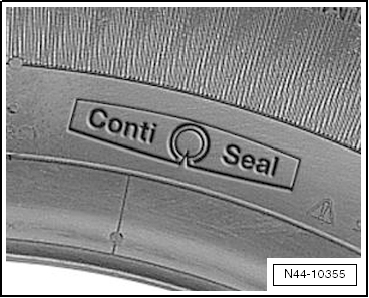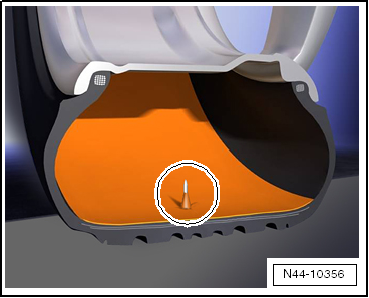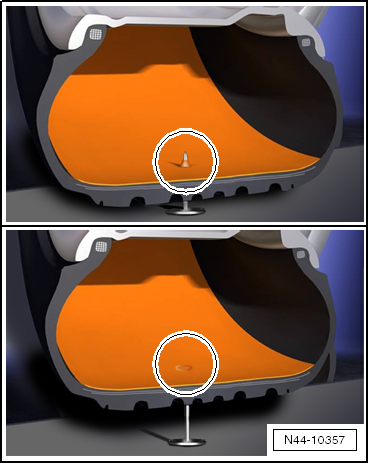Volkswagen Polo Service & Repair Manual: Run-Flat Tire, Seal Inside-Technology
| The vehicle can be equipped with run-flat tires as an
option. |
| The Seal Inside technology is a system that allows the
vehicle to continue driving even if the tire has been punctured
by a nail or screw: a protective coating on the inside of the
tire automatically seals any holes caused by a screw or a nail. |
| This way no air can escape. The sealant can work on almost
all types of leaks, that result from objects with a diameter of
up to 5 millimeters. |
 Note Note
| It is not recommended to use a mix of different tire types
i.e. run-flat and “normal” tires. |
| The seal inside technology has already been incorporated by
the tire manufacturer into the tire manufacturing process. |
| The seal inside technology is a self-adhering, viscous
sealant, which is evenly applied to the inner side of the
running surface from shoulder to shoulder. |
| The sealant is an integral component of mobility tires. |
| There is a special logo on the side wall of the tire which
identifies it as a mobility tire. |
|
|
|
| Example: the sidewall of a Continental tire |
 Caution
Caution
| The sealant is not intended to be a permanent tire
repair after a puncture has happened. |
|
|
|

|
| If a foreign object with a diameter up to 5 mm punctures the
running surface of a mobility tire, the sealant immediately
closes the puncture and seals it to prevent air leakage. |
|
|

|
| The sealant is designed to seal most punctures caused by a
foreign object, which has a diameter up to 5 mm. |
| The Seal Inside technology reduces the frequency of flat
tires, but it is not intended to make is possible to drive on a
tire which has minimum tire pressure or is completely flat. |
| Mobility tires have all the same characteristics as tires
without the Seal Inside technology. |
| When working with mobility tires it is especially important
to pay attention to cleanliness and to how the tires are stored. |
| The sealant in the inner side of the tire running surface is
not protected and therefore is subject to any type of dirt. |
| It is recommended to store the tires in large bags or
something similar. |
| As with other tires, the mobility tires should be checked
regularly for signs of cuts, punctures and air pressure loss. |
| The tires should be inspected at least one or twice a month
and/or always after a long trip. |
| If punctures or damage are not taken care of in a timely
manner, the result may be a loss of pressure and/or the tire
could fail. |
| Mobility tires with cuts or punctures must be immediately
inspected. |
| It must be decided if the tire should be removed and
scrapped. |
| Mounting and dismounting a mobility tire is identical to
that of a standard tire. |
|
|

|
Run-Flat Tires, Dismounting and Mounting. Refer to
→ Chapter „Tires, Mounting“.
A Tire Pressure Monitoring Display is Necessary When Us ...
PAX tires involve specially developed system that exhibits
the following differences in comparison to conventional tires:
Pax Tires with Supporting R ...
Other materials:
Indicator lamps
First read and observe the introductory information
and safety warnings
Lit up
Possible cause
Solution
Engine management system fault (Electronic Power Control).
The engine should be checked by a qualified workshop
as s ...
Engine oil specification
First read and observe the introductory information
and safety warningsThe engine oil used must correspond exactly to specifications.
The correct engine oil is important for the function and service life of the
engine. A special high quality multigrade oil has been filled at the factory and
t ...
Warning and indicator lamp
First read and observe the introductory information
and safety warnings
Lit up
Possible cause
Solution
Dual clutch gearbox DSG® overheated.
Do not drive on!
Move the selector lever to position P and leave the gearbox
...
© 2016-2025 Copyright www.vwpolo.net

 Note
Note Run-Flat Tire, Structure and Identification, SST Tire
Run-Flat Tire, Structure and Identification, SST Tire Run-Flat Tire, Overview of a PAX Tire
Run-Flat Tire, Overview of a PAX Tire
 Caution
Caution

